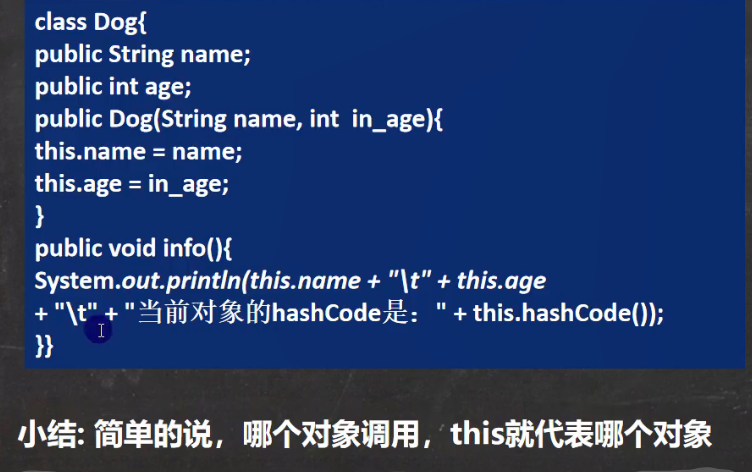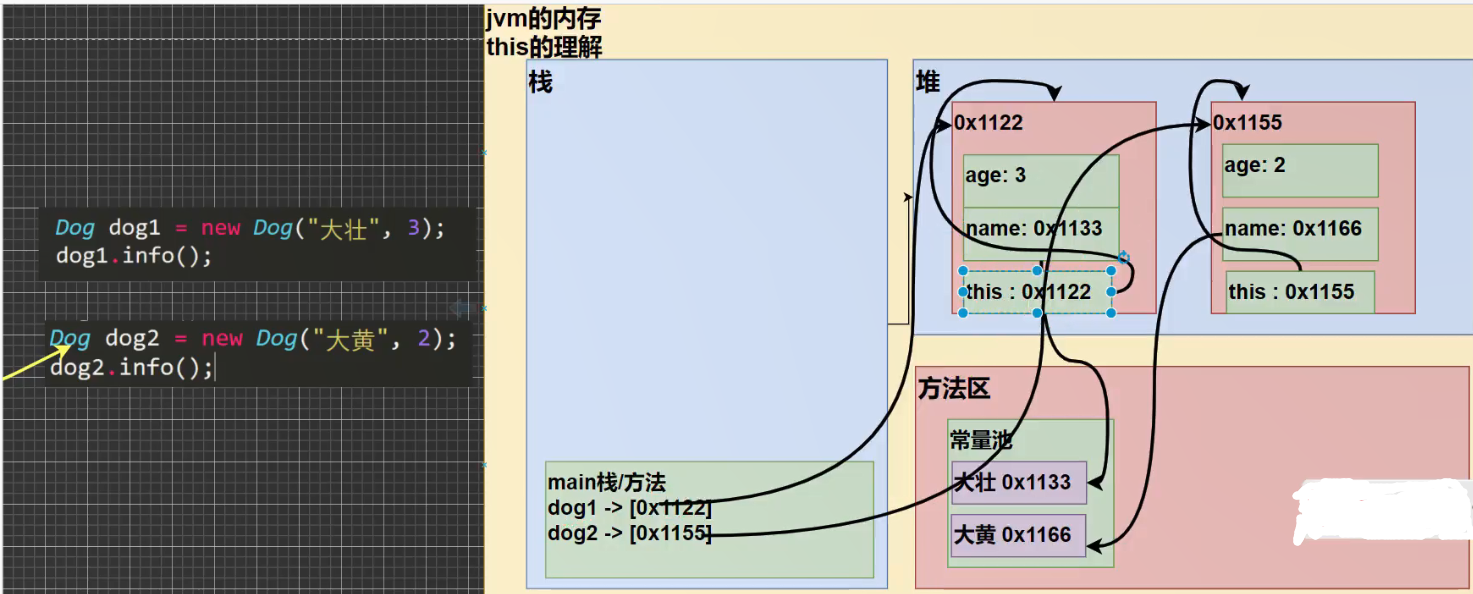this 关键字基本使用
-
什么是this
public class This01 { public static void main(String[] args) { Dog dog1 = new Dog("大壮", 3); //dog1调用了 info()方法 dog1.info(); } } class Dog{ //类 String name; int age; // public Dog(String dName, int dAge){//构造器 // name = dName; // age = dAge; // } //如果我们构造器的形参,能够直接写成属性名,就更好了 //但是出现了一个问题,根据变量的作用域原则 //构造器的name 是局部变量,而不是属性 //构造器的age 是局部变量,而不是属性 //==> 引出this关键字来解决 public Dog(String name, int age){//构造器 //this.name 就是当前对象的属性name this.name = name; //this.age 就是当前对象的属性age this.age = age; } public void info(){//成员方法,输出属性x信息 System.out.println(name + "\t" + age + "\t"); } } -
深入理解 this


-
使用
hashCode()看看对象的情况
public class This01 { public static void main(String[] args) { Dog dog1 = new Dog("大壮", 3); System.out.println("dog1的hashcode=" + dog1.hashCode()); //dog1调用了 info()方法 dog1.info(); System.out.println("============"); Dog dog2 = new Dog("大黄", 2); System.out.println("dog2的hashcode=" + dog2.hashCode()); dog2.info(); } } class Dog{ //类 String name; int age; public Dog(String name, int age){//构造器 //this.name 就是当前对象的属性name this.name = name; //this.age 就是当前对象的属性age this.age = age; System.out.println("this.hashCode=" + this.hashCode()); } public void info(){//成员方法,输出属性x信息 System.out.println("this.hashCode=" + this.hashCode()); System.out.println(name + "\t" + age + "\t"); } }
-
this 的注意事项和使用细节
-
this 关键字可以用来访问本类的属性、方法、构造器
-
this 用于区分当前类的属性和局部变量
public class ThisDetail { public static void main(String[] args) { T t = new T(); t.f3(); } } class T{ String name = "兮动人"; int num = 10; //this关键字可以用来访问本类的属性 public void f3(){ String name = "smith"; //传统方式 System.out.println("name=" + name + " num=" + num);//smith 100 //也可以使用this访问属性 System.out.println("name=" + this.name + " num=" + this.num);//jack 100 } } -
访问成员方法的语法:this.方法名(参数列表);
public class ThisDetail { public static void main(String[] args) { T t1 = new T(); t.f2(); } } class T { public void f1(){ System.out.println("f1()方法..."); } public void f2(){ System.out.println("f2()方法..."); //调用本类的 f1 //第一种方式 f1(); //第二种方式 this.f1(); } } -
访问构造器语法:
this(参数列表);注意只能在构造器中使用(即只能在构造器中访问另外一个构造器, 必须放在第一条语句)public class ThisDetail { public static void main(String[] args) { T t2 = new T(); } } class T{ /* 细节: 访问构造器语法:this(参数列表); 注意只能在构造器中使用(即只能在构造器中访问另外一个构造器) 注意: 访问构造器语法:this(参数列表); 必须放置第一条语句 */ public T(){ //这里去访问 T(String name,int age)构造器,必须放在第一行 this("Jack", 23); System.out.println("T()构造器"); } public T(String name,int age){ System.out.println("T(String name,int age)构造器"); } } -
this 不能在类定义的外部使用,只能在类定义的方法中使用。
-
-
this 的案例
-
定义 Person 类,里面有 name、age 属性,并提供 compareTo 比较方法,用于判断是否和另一个人相等,提供测试类 TestPerson 用于测试, 名字和年龄完全一样,就返回 true, 否则返回 false
public class TestPerson { public static void main(String[] args) { Person p1 = new Person("mary", 20); Person p2 = new Person("mary", 20); System.out.println("p1和p2比较的结果=" + p1.compareTo(p2)); } } /* 定义Person类,里面有name、age属性,并提供compareTo比较方法, 用于判断是否和另一个人相等,提供测试类TestPerson用于测试, 名字和年龄完全一样,就返回true, 否则返回false */ class Person { String name; int age; //构造器 public Person(String name, int age) { this.name = name; this.age = age; } //compareTo比较方法 public boolean compareTo(Person p) { //名字和年龄完全一样 // if(this.name.equals(p.name) && this.age == p.age) { // return true; // } else { // return false; // } return this.name.equals(p.name) && this.age == p.age; } }
-





















 2227
2227











 被折叠的 条评论
为什么被折叠?
被折叠的 条评论
为什么被折叠?








